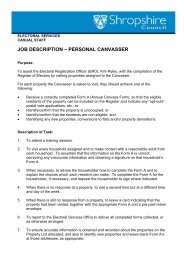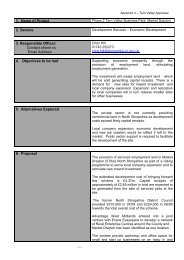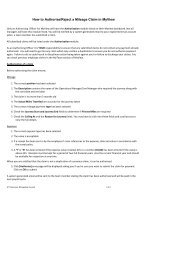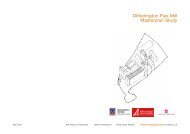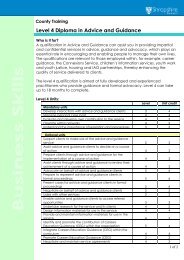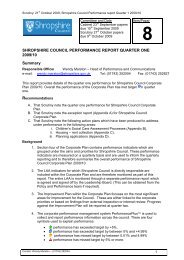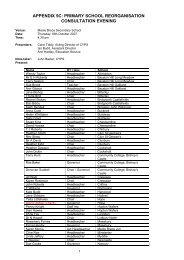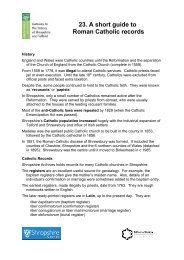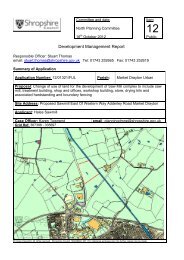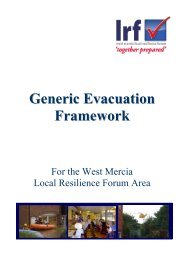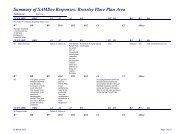Report No 9 Engine and Tender Inn Brooome - Shropshire Council
Report No 9 Engine and Tender Inn Brooome - Shropshire Council
Report No 9 Engine and Tender Inn Brooome - Shropshire Council
Create successful ePaper yourself
Turn your PDF publications into a flip-book with our unique Google optimized e-Paper software.
Contact: Stuart Thomas (01743) 252665<br />
Committee <strong>and</strong> date<br />
South Planning Committee<br />
4 December 2012<br />
Development Management <strong>Report</strong><br />
Item/Paper<br />
9<br />
Responsible Officer: Stuart Thomas<br />
email: stuart.thomas@shropshire.gov.uk Tel: 01743 252665 Fax: 01743 252619<br />
Summary of Application<br />
Application Number: 12/03473/FUL<br />
Parish:<br />
Hopesay<br />
Proposal: Conversion of existing public house into two residential units<br />
Site Address: <strong>Engine</strong> And <strong>Tender</strong> <strong>Inn</strong> Broome Craven Arms <strong>Shropshire</strong> SY7 0NT<br />
Applicant: Mr R Burton<br />
Case Officer: Julie Preston email: planningdmsw@shropshire.gov.uk<br />
Grid Ref: 339955 - 281113<br />
© Crown Copyright. All rights reserved. <strong>Shropshire</strong> <strong>Council</strong> 100049049. 2011 For reference purposes only. <strong>No</strong> further copies may be made.
South Planning Committee: 4 December 2012<br />
Recommendation:- That subject to the receipt of a response from Natural Engl<strong>and</strong> <strong>and</strong><br />
assessment of the proposal under the terms of the Habitat Regulations, Officers be<br />
authorised to Grant Permission subject to a section 106 Agreement to secure an<br />
affordable housing contribution <strong>and</strong> the conditions set out in Appendix 1.<br />
Recommended Reason for Approval<br />
Whilst the loss of the potential community facility is regrettable, evidence submitted<br />
demonstrates that the reopening of the public house is unlikely in the foreseeable future due to<br />
the limited catchment of the rural location <strong>and</strong> the commercial viability of the business.<br />
It is considered that the change of use of the building to two dwellings would not have a<br />
significant impact on social facilities in the area due to the presence of other public houses in<br />
nearby settlements.<br />
In determining the application the Local Planning Authority gave consideration to the following<br />
policies:<br />
National Planning Policy Framework<br />
Part 1: Building a strong, competitive economy<br />
Part 3. Supporting a prosperous rural economy<br />
Part 6: Delivering a wide choice of high quality homes<br />
Part 7: Requiring good design<br />
Part 8: Promoting Healthy Communities<br />
Core Strategy Development Plan Document<br />
CS5 Countryside <strong>and</strong> Green Belt<br />
CS6 Sustainable Design <strong>and</strong> Development Principles<br />
CS8: Facilities, Services <strong>and</strong> Infrastructure Provision<br />
CS11 Type <strong>and</strong> Affordability of Housing<br />
CS13 Economic Development, Enterprise <strong>and</strong> Employment<br />
CS16 Tourism, Culture <strong>and</strong> Leisure<br />
CS17 Environmental Networks<br />
REPORT<br />
1.0 THE PROPOSAL<br />
1.1 The proposal is for the change of use of the <strong>Engine</strong> <strong>and</strong> <strong>Tender</strong> <strong>Inn</strong> to two<br />
dwellings. The public house ceased trading in January 2011 <strong>and</strong> the living<br />
accommodation is occupied by the applicant <strong>and</strong> his family. The <strong>Inn</strong> originally<br />
comprised two properties, the public house <strong>and</strong> barns on the west side <strong>and</strong> Broome<br />
Villa to the east.<br />
1.2<br />
The proposal involves demolishing a recent flat roofed extension linking the pub to<br />
the barn <strong>and</strong> dividing the property into two by filling openings in the party wall. Two<br />
semi-detached three bedroom dwellings would be created each with a separate<br />
curtilage. Alterations include the addition of a window to a side elevation <strong>and</strong> the<br />
making good of render <strong>and</strong> the roof where a chimney will be removed. There is an<br />
existing access which will serve the dwelling on the west side <strong>and</strong> a new access<br />
will be created for the house on the east side.<br />
Contact: Stuart Thomas (01743) 252665
South Planning Committee: 4 December 2012<br />
1.3<br />
The application is accompanied by a statement in support of the proposal <strong>and</strong> a<br />
completed affordable housing contribution form confirming agreement to pay<br />
£11,700 for the additional residential unit created.<br />
2.0 SITE LOCATION/DESCRIPTION<br />
2.1 The property is a detached building set back off the B4369 in the village of Broome,<br />
south west of Craven Arms. A large barn is situated to the rear of the building <strong>and</strong><br />
joined to the public house by a flat roofed extension. This extension houses toilets<br />
<strong>and</strong> facilities for touring caravans. To the west of the property is a large former car<br />
park. L<strong>and</strong> to the rear of the barn contains four mobile homes <strong>and</strong> four touring<br />
caravans. Two mobile homes are unauthorised <strong>and</strong> the touring caravans are not<br />
sited in accordance with their planning permission. The site has been the subject of<br />
complaints that are being followed up by the Enforcement Team.<br />
3.0 REASON FOR COMMITTEE DETERMINATION OF APPLICATION<br />
3.1 The application is referred to committee as the Parish <strong>Council</strong> has recommended<br />
the application be refused which is contrary to the Officer recommendation that<br />
planning permission be granted for the proposed change of use.<br />
4.0 Community Representations<br />
Consultee Comments<br />
4.1 SC Drainage<br />
<strong>No</strong> objections<br />
4.2 SC Ecologist<br />
A formal consultation with Natural Engl<strong>and</strong> is required relating to potential waste<br />
water impacts upon the River Clun SAC. The formal response of Natural Engl<strong>and</strong> is<br />
required to allow a Habitat Regulation Assessment to be undertaken by <strong>Shropshire</strong><br />
<strong>Council</strong> Ecologists.<br />
Bats<br />
In my pre-application advice dated 31 January 2012 I stipulated that a bat survey<br />
would be required for the proposed conversion. A bat survey has not been provided<br />
but from the proposed plans I can see that the only physical alterations to the<br />
building are the removal of the single storey modern linking structure <strong>and</strong> the repair<br />
of an area where the chimney has been removed. On this basis I am satisfied that<br />
the potential for bats to be impacted is small even if they are roosting in the<br />
building.<br />
Nesting Wild Birds<br />
The site has potential for nesting Wild Birds to be present. The following informative<br />
should be on the decision notice:<br />
Habitat Regulation Assessment<br />
This development is within the water catchment for the River Clun <strong>and</strong> is upstream<br />
of the River Teme SSSI <strong>and</strong> the River Clun SAC. The River Clun SAC is currently<br />
failing its water quality targets <strong>and</strong> <strong>Shropshire</strong> <strong>Council</strong> is working closely with<br />
Natural Engl<strong>and</strong> <strong>and</strong> Environment Agency on developments within the Clun<br />
catchment. <strong>Shropshire</strong> <strong>Council</strong> formally consults Natural Engl<strong>and</strong> on any planning<br />
Contact: Stuart Thomas (01743) 252665
South Planning Committee: 4 December 2012<br />
application within the Clun catchment <strong>and</strong> must complete a Habitat Regulation<br />
Assessment screening once the response of Natural Engl<strong>and</strong> is received.<br />
Any proposed development within the Clun catchment will need to be supported by<br />
detailed information relating to drainage <strong>and</strong> foul water treatment. Details of the<br />
proposed drainage <strong>and</strong> foul water treatment <strong>and</strong> discharge should be provided with<br />
the planning application including identifying the watercourse to which any<br />
proposed discharge will be made, proposed waste water treatment method <strong>and</strong> an<br />
assessment of the nutrient load within any proposed output.<br />
4.3 SC Highways DC<br />
The visibility to the right for drivers exiting the existing public house car park is<br />
restricted by the position of the boundary hedge <strong>and</strong> I would recommend that this is<br />
set back to improve the situation. Having regard however for the existing approved<br />
use of the site <strong>and</strong> the vehicle movements this has the potential to generate, I do<br />
not consider that this concern would justify a highway objection to the scheme.<br />
The access to plot number 2 is as existing <strong>and</strong> I have no objection to the use of this<br />
for the proposed dwelling.<br />
I do not raise any highway objections in principle to permission being granted for<br />
this application.<br />
4.4 SC Affordable Houses<br />
I can confirm that the contribution figure of £11,700 given on the Affordable<br />
Housing Pro-forma is correct for conversion of this existing building.<br />
4.5 Natural Engl<strong>and</strong><br />
<strong>No</strong> response to consultation at the time of writing the report. Any advice received<br />
will be reported at the meeting.<br />
4.6 Hopesay Parish <strong>Council</strong>:<br />
Hopesay Parish <strong>Council</strong> resolved to object to the application on the grounds that<br />
proper action to sell the <strong>Engine</strong> <strong>and</strong> <strong>Tender</strong> at a realistic price does not appear to<br />
have been taken.<br />
Hopesay Parish <strong>Council</strong> considered the above application at its meeting on<br />
Monday 17th September 2012 <strong>and</strong> decided to object to the application on the basis<br />
that there was concern in the community at the loss of an important community<br />
asset, <strong>and</strong> that the application should only be considered if the premises had been<br />
offered for sale at a realistic price reflecting the current market value.<br />
Prior to <strong>Council</strong> addressing this issue under the agenda item covering planning, the<br />
matter was discussed in public session which was attended by 14 members of the<br />
public <strong>and</strong> the architect representing the applicant. <strong>No</strong>tes of the public discussion<br />
session are attached. These show that of the 14 residents present, 4 spoke<br />
opposing the application with none in favour. Others expressed sympathy with the<br />
applicant resulting from the current difficult trading conditions but the general<br />
opinion was that the business had not been properly run since the change of<br />
Contact: Stuart Thomas (01743) 252665
South Planning Committee: 4 December 2012<br />
ownership <strong>and</strong> that the asking price for the property was not realistic.<br />
The decision of Hopesay Parish <strong>Council</strong> is therefore to object the application for the<br />
reasons stated in the first paragraph. Hopesay Parish <strong>Council</strong> would also ask<br />
<strong>Shropshire</strong> <strong>Council</strong> to review the current <strong>and</strong> future use of the property as a<br />
builder’s yard/business, either as part of this application or as a separate issue, as<br />
<strong>Council</strong> is not aware of any decision permitting such use.<br />
4.7 <strong>Shropshire</strong> Fire <strong>and</strong> Rescue:<br />
Comments on access for emergency vehicles <strong>and</strong> the benefit of sprinkler systems<br />
4.8<br />
Public Comments<br />
Five letters of objection have been received to the proposal making the following<br />
points:<br />
• The pub has not been on the market for a realistic price <strong>and</strong> therefore would<br />
not attract a buyer who would be able to develop the business. The pub was<br />
put up for sale at £550.000 which is at least £200,000 over a realistic sale<br />
price.<br />
• There is no other pub in Broome <strong>and</strong> the conversion to two dwellings would<br />
be contrary to the <strong>Council</strong>’s tourism <strong>and</strong> economic regeneration policy.<br />
South <strong>Shropshire</strong> relies on maintaining a range of pubs <strong>and</strong> cafes to service<br />
residents <strong>and</strong> visitors.<br />
• The pub was attractive to users of the Heart of Wales line <strong>and</strong> in the right<br />
h<strong>and</strong>s could attract events such as Folk Down the Track.<br />
• There is considerable evidence to indicate that pubs can be viable trading<br />
concerns in South <strong>Shropshire</strong>. The Sitwell Arms in Bucknell was sold as a<br />
going concern <strong>and</strong> is now building business. The Tally Ho has come back to<br />
the market <strong>and</strong> serves the Peaton/Bouldon area <strong>and</strong> the Sun <strong>Inn</strong> at<br />
Leintwardine goes from strength to strength; these are all examples of pubs<br />
closing <strong>and</strong> returning to viability with new ownership. There are also<br />
numerous examples of pubs being revived in Herefordshire too. The<br />
Maidenhead at Orleton exchanged h<strong>and</strong>s commercially as did the Roebuck<br />
at Brimfield. The case is well made in terms of pubs on the Heart of Wales<br />
line too. The Greyhound at Llangunllo has re-opened as has the Hundred<br />
House at Bleddfa.<br />
• The pub is a resource for campers <strong>and</strong> could generate significant income for<br />
the local community. The <strong>Engine</strong> <strong>and</strong> <strong>Tender</strong> was popular as a venue for<br />
groups of friends to meet for weekends camping <strong>and</strong><br />
walking/cycling/holiday-making. Good country pubs with campsites attached<br />
are rare <strong>and</strong> make visiting an area feasible for those enjoying the outdoors<br />
<strong>and</strong> a pint at the end of the day. There are very few other campsites with<br />
adjoining or nearby pubs in the <strong>Shropshire</strong> AONB <strong>and</strong> most of them are<br />
usually fully-booked months in advance (e.g. Small Batch campsite in Little<br />
Stretton).<br />
Contact: Stuart Thomas (01743) 252665
South Planning Committee: 4 December 2012<br />
• The pub was busy <strong>and</strong> in dem<strong>and</strong>. It was particularly popular with people<br />
from Birmingham, the Black Country <strong>and</strong> West Midl<strong>and</strong>s generally, including<br />
weekend bikers, for whom the <strong>Shropshire</strong> Hills AONB is one of the nearest<br />
areas of outst<strong>and</strong>ing natural beauty <strong>and</strong> significantly hilly area.<br />
• The mobile homes at the rear of the site are being used as dwellings.<br />
• The country pub is a cherished English institution. The previous owners of<br />
the pub ran a successful business which also brought business to the<br />
Kangaroo <strong>Inn</strong> nearby in Aston on Clun. A symbiotic relationship between the<br />
two pubs grew from the caravan trade with large groups of bikers arriving<br />
during the summer <strong>and</strong> visiting the Kangaroo <strong>Inn</strong>.<br />
• The current owners had no experience of the pub trade <strong>and</strong> were previously<br />
in the construction business. The pub was been steadily run down.<br />
• The pub was not previously two buildings because there was nothing there<br />
before the pub was built. It was originally the Railway Tavern <strong>and</strong> purpose<br />
built by the L&NW Railway when the railway village of Broome came into<br />
being in 1860.<br />
• Everyone should be concerned about the decreasing viability of amenities in<br />
small communities like Broome <strong>and</strong> Aston on Clun. Aston has lost its shop<br />
<strong>and</strong> post office <strong>and</strong> the Kangaroo <strong>Inn</strong> is in a precarious state. Broome will be<br />
added to the increasing number of dead retirement villages bereft of a pub,<br />
shop or any other amenity.<br />
5.0 THE MAIN ISSUES<br />
Principle of development<br />
6.0 OFFICER APPRAISAL<br />
6.1 Principle of development<br />
6.1 The main issue that arises in considering an application for the conversion of a<br />
public house to one or more dwellings is whether the planning system should<br />
prevent the permanent loss of a community facility.<br />
6.2 Policy Background<br />
The National Planning Policy Framework (NPPF) sets out the government’s<br />
planning policies <strong>and</strong> how these are expected to be applied. In trying to achieve<br />
sustainable development, the planning system has a social role -<br />
supporting strong, vibrant <strong>and</strong> healthy communities, by providing the supply of housing<br />
required to meet the needs of present <strong>and</strong> future generations; <strong>and</strong> by creating a high<br />
quality built environment, with accessible local services that reflect the community’s needs<br />
<strong>and</strong> support its health, social <strong>and</strong> cultural well-being.<br />
Contact: Stuart Thomas (01743) 252665
South Planning Committee: 4 December 2012<br />
6.3 To support a prosperous rural economy the NPPF promotes the retention <strong>and</strong><br />
development of local services <strong>and</strong> community facilities, including public houses<br />
(para. 28). The NPPF also seeks to promote healthy communities by delivering<br />
social, recreational <strong>and</strong> cultural facilities <strong>and</strong> services to meet the needs of the<br />
community. Planning decisions should guard against the unnecessary loss of<br />
valued facilities <strong>and</strong> services, particularly where this would reduce the community’s<br />
ability to meet its day to day needs (para. 70).<br />
6.4 In paragraph 51 of the NPPF, local planning authorities are required to identify <strong>and</strong><br />
bring back into residential use empty housing <strong>and</strong> buildings in line with local<br />
housing <strong>and</strong> empty homes strategies. Authorities should normally approve planning<br />
applications for change to residential use <strong>and</strong> any associated development from<br />
commercial buildings where there is an identified need for additional housing in that<br />
area, provided that there are not strong economic reasons why such development<br />
would be inappropriate.<br />
6.5 The important contribution of facilities <strong>and</strong> services to social <strong>and</strong> economic vitality is<br />
recognised at a local level in Core Strategy policies CS 6 Sustainable Design <strong>and</strong><br />
Development Principles <strong>and</strong> CS 8: Facilities, Services <strong>and</strong> Infrastructure Provision.<br />
These policies recognise that facilities <strong>and</strong> services, including pubs, have a direct<br />
effect on the quality of life of <strong>Shropshire</strong>’s residents. Proposals that would result in<br />
the loss of a service or facility should be resisted unless it can be clearly<br />
demonstrated that the service or facility is not viable over the long term.<br />
6.6 In respect of conversions of heritage assets to houses for sale on the open market,<br />
Policy CS 6 requires proposals to demonstrate that they take account of the<br />
character of the building <strong>and</strong> contribute to rebalancing the rural area by making a<br />
financial contribution towards affordable housing.<br />
6.7 To sum up, there is a general presumption against the loss of public houses in rural<br />
areas <strong>and</strong> the viability of the facility <strong>and</strong> the contribution it makes to social<br />
sustainability needs to be explored further before considering the conversion of the<br />
building into two dwellings.<br />
6.8 Analysis<br />
The <strong>Engine</strong> <strong>and</strong> <strong>Tender</strong> <strong>Inn</strong> has been closed for close on two years. <strong>No</strong>netheless, a<br />
public house is the permitted use of the building <strong>and</strong> granting consent for a change<br />
of use to residential would permanently remove this community asset <strong>and</strong> any<br />
potential for its reinstatement.<br />
6.9 It is acknowledged that rural pubs face a number of issues with regard to their<br />
continued operation; drink drive legislation, the smoking ban, increasing duty on<br />
alcohol sales <strong>and</strong> the easy availability of low price alcohol from high street stores<br />
<strong>and</strong> supermarkets, along with social change <strong>and</strong> economic hardship meaning a<br />
general reduction in disposable income. However, the planning process, through<br />
change of use applications, offers the only publicly accessible forum for debate<br />
about the future of individual public houses. Whilst it is not feasible for every pub to<br />
be retained, it is important to ensure that a robust assessment of the viability of the<br />
business, perhaps under new ownership or tenancy, is undertaken, <strong>and</strong> that only if<br />
the business is shown to be unviable should an application for change of use be<br />
granted.<br />
Contact: Stuart Thomas (01743) 252665
South Planning Committee: 4 December 2012<br />
6.10 To test viability local planning authorities have generally required evidence of the<br />
marketing of the property with an appropriate specialist agent at a price that reflects<br />
the value of the business for a minimum period of 12 months. A log should be kept<br />
by the selling agent recording expressions of interest. The availability of alternative<br />
social facilities in the village is also relevant <strong>and</strong> CAMRA (Campaign For Real Ale)<br />
have produced a useful Public House Viability Test to assess trade potential in a<br />
proposed change of use situation. The test suggests that the following are<br />
considered:<br />
1) Population Density – Pub location <strong>and</strong> catchment area, proposed nearby<br />
developments, daytime working population <strong>and</strong> adult population.<br />
2) Visitor potential – Does the pub benefit from a popular location, tourist or<br />
community activities. Do people drive to it?<br />
3) Competition – How many pubs in a one mile radius? Does the pub cater for<br />
different groups?<br />
4) Flexibility Of The Site – Is the pub well maintained, have unused areas,<br />
buildings or space for expansion? What is its planning history?<br />
5) Parking – Is it appropriate or can it be extended?<br />
6) Public Transport – What provision exists in the area – bus, rail, safe walk? Is<br />
there a local taxi firm?<br />
7) Multiple Use – What is the extent of community facilities in the area? If none<br />
could the pub incorporate any?<br />
Last but not least, it is acknowledged that there is a difference between a genuinely<br />
unviable business <strong>and</strong> a business that is badly managed. Consideration of the<br />
factors above assist in determining the application.<br />
6.11 Marketing<br />
The applicants bought the public house in May 2005 <strong>and</strong> made a small profit in two<br />
out of the six years of trading. Losses were typically in the region of £10,000 to<br />
£15,000 per year. Sales peaked in 2007/08 <strong>and</strong> then dropped significantly to<br />
January 2011 when the pub ceased trading. The property was marketed for sale<br />
from October 2010 to December 2011 by Meridian Business Sales Ltd. The<br />
property appeared on seven websites <strong>and</strong> many others through multi-site<br />
distribution.<br />
6.12 The property was initially marketed for £550,000. It is important to bear in mind that<br />
the property extends over 0.48 ha including the field containing the caravans <strong>and</strong><br />
includes the public house with five bedroom accommodation <strong>and</strong> a large barn<br />
which has previously had planning permission for conversion to two holiday units.<br />
The price was subsequently reduced as follows: <strong>No</strong>vember 2010 - £500,000,<br />
August 2011 - £475,000 <strong>and</strong> <strong>No</strong>vember 2011 - £450,000. <strong>No</strong>twithst<strong>and</strong>ing the price<br />
reductions there was only one viewing which did not result in an offer. A quick trawl<br />
of the internet did not result in any similar properties to compare prices but general<br />
opinion is that the advertised price does appear to be on the high side to achieve a<br />
quick sale <strong>and</strong> the property was not left on the market for long at the lower figure of<br />
£450,000.<br />
Contact: Stuart Thomas (01743) 252665
South Planning Committee: 4 December 2012<br />
6.13 Potential<br />
A public house falls into Use Class A4 <strong>and</strong> planning permission would not be<br />
required to change to Class A1 (shops), A2 (financial <strong>and</strong> professional services)<br />
<strong>and</strong> A3 (restaurant <strong>and</strong> café). An alternative use or more than one local service<br />
could be provided from a building such as The <strong>Engine</strong> <strong>and</strong> <strong>Tender</strong> without the need<br />
for planning permission. This potentially increases the value of the building as a<br />
community facility.<br />
6.14 Broome has a population of 100 <strong>and</strong> has a largely rural hinterl<strong>and</strong>. Aston on Clun is<br />
the nearest neighbouring village. The Kangaroo <strong>Inn</strong> is located in Aston on Clun <strong>and</strong><br />
is about half a mile away from the <strong>Engine</strong> <strong>and</strong> <strong>Tender</strong>. There is also a village hall<br />
nearby that serves the two villages. <strong>No</strong> further housing development is anticipated<br />
in either settlement. There are public houses at Purslow (2.5 miles), Clunton (4.4<br />
miles) <strong>and</strong> Clun (6.8 miles). These villages are situated on the B4368 to the west of<br />
Broome. Craven Arms is the nearest settlement of any size (population around<br />
3,000) <strong>and</strong> is just over 2 miles away to the east. There are at least three pubs in the<br />
town. The population of the potential catchment area cannot be considered high<br />
even taking into account the fact that people will travel further to a pub that has a<br />
reputation for good food or specific facilities.<br />
6.15 Broome is a small village on a minor road that grew with the arrival of the railway. It<br />
does not have interesting buildings or other attractions. However, the area is<br />
popular with visitors as a destination to enjoy good walking country. From the<br />
letters of representation it also appears that the camping was popular with bikers<br />
<strong>and</strong> visitors from the West Midl<strong>and</strong>s. There is potential for improving the camping<br />
<strong>and</strong> caravanning facilities on the site. The pub has been closed for some time <strong>and</strong><br />
the site currently has a run down appearance. There is plenty of scope for<br />
improving facilities, converting the barn <strong>and</strong> developing the tourism potential.<br />
6.16 The site benefits from plenty of on-site parking provision <strong>and</strong> a curtilage that is<br />
substantial <strong>and</strong> could provide an outside area for customer use. Although the site is<br />
close to a bus route <strong>and</strong> train service, services are very infrequent. Most customers<br />
would undoubtedly use a car or walk if they lived close by.<br />
7.0 CONCLUSION<br />
7.1 The loss of a public house is regrettable particularly where they have served an<br />
area for many years. The <strong>Engine</strong> <strong>and</strong> <strong>Tender</strong> has already closed <strong>and</strong> the accounts<br />
submitted demonstrate that the reopening of the public house is unlikely in the<br />
foreseeable future due to the limited catchment of the rural location <strong>and</strong> the<br />
commercial viability of the business. The building has the potential to provide<br />
facilities for visitors but the investment necessary seems unlikely in the present<br />
economic climate. The weak point in the applicant’s case is that the pub has been<br />
marketed for sale but arguably not at a price that would attract interest. However, it<br />
has to be acknowledged that there is another public house within half a mile of the<br />
<strong>Engine</strong> <strong>and</strong> <strong>Tender</strong> that can meet the needs of the area for this type of social<br />
facility.<br />
7.2 In terms of location <strong>and</strong> impact on surrounding properties, there is no reason why a<br />
change of use to two dwellings would not be suitable in this location. The building is<br />
capable of conversion without significant extension or alteration, <strong>and</strong> dwellings are<br />
unlikely to have a greater impact on the area than the reinstatement of the extant<br />
Contact: Stuart Thomas (01743) 252665
South Planning Committee: 4 December 2012<br />
public house use of the property. The applicant intends that the barn <strong>and</strong> caravan<br />
site will remain with one of the dwellings <strong>and</strong> this offers the potential to provide<br />
visitor accommodation at some point in the future.<br />
7.3 Taking into account all the relevant information submitted it is recommended that,<br />
on balance, the proposal should be granted permission subject to completion of a<br />
section 106 Agreement to secure a payment towards affordable housing. In<br />
addition, the process of considering the application under the Habitat Regulations<br />
Assessment (HRA) has not been completed. The advice of Natural Engl<strong>and</strong> has<br />
not been received on the impact of the proposal on the River Clun SAC (para. 4.2<br />
refers). Members are therefore requested to give officers delegated powers to<br />
consider the HRA issues following receipt of Natural Engl<strong>and</strong>’s response before<br />
planning permission is granted.<br />
8.0 Risk Assessment <strong>and</strong> Opportunities Appraisal<br />
8.1 Risk Management<br />
There are two principal risks associated with this recommendation as follows:<br />
As with any planning decision the applicant has a right of appeal if they disagree<br />
with the decision <strong>and</strong>/or the imposition of conditions. Costs can be awarded<br />
irrespective of the mechanism for hearing the appeal, i.e. written representations,<br />
hearing or inquiry.<br />
The decision may be challenged by way of a Judicial Review by a third party. The<br />
courts become involved when there is a misinterpretation or misapplication of policy<br />
or some breach of the rules of procedure or the principles of natural justice.<br />
However their role is to review the way the authorities reach decisions, rather than<br />
to make a decision on the planning issues themselves, although they will interfere<br />
where the decision is so unreasonable as to be irrational or perverse. Therefore<br />
they are concerned with the legality of the decision, not its planning merits. A<br />
challenge by way of Judicial Review must be made a) promptly <strong>and</strong> b) in any event<br />
not later than three months after the grounds to make the claim first arose.<br />
Both of these risks need to be balanced against the risk of not proceeding to<br />
determine the application. In this scenario there is also a right of appeal against<br />
non-determination for application for which costs can also be awarded.<br />
8.2 Human Rights<br />
Article 8 give the right to respect for private <strong>and</strong> family life <strong>and</strong> First Protocol Article<br />
1 allows for the peaceful enjoyment of possessions. These have to be balanced<br />
against the rights <strong>and</strong> freedoms of others <strong>and</strong> the orderly development of the<br />
County in the interests of the Community.<br />
First Protocol Article 1 requires that the desires of l<strong>and</strong>owners must be balanced<br />
against the impact on residents.<br />
This legislation has been taken into account in arriving at the above<br />
recommendation.<br />
Contact: Stuart Thomas (01743) 252665
South Planning Committee: 4 December 2012<br />
8.3 Equalities<br />
The concern of planning law is to regulate the use of l<strong>and</strong> in the interests of the<br />
public at large, rather than those of any particular group. Equality will be one of a<br />
number of ‘relevant considerations’ that need to be weighed in Planning Committee<br />
members’ minds under section 70(2) of the Town <strong>and</strong> Country Planning Act 1970.<br />
9.0 Financial Implications<br />
There are likely financial implications of the decision <strong>and</strong>/or imposition of conditions<br />
if challenged by a planning appeal or judicial review. The costs of defending any<br />
decision will be met by the authority <strong>and</strong> will vary dependant on the scale <strong>and</strong><br />
nature of the proposal. Local financial considerations are capable of being taken<br />
into account when determining this planning application – in so far as they are<br />
material to the application. The weight given to this issue is a matter for the<br />
decision maker.<br />
10. Background<br />
Relevant Planning Policies<br />
National Planning Policy Framework<br />
Part 1: Building a strong, competitive economy<br />
Part 3. Supporting a prosperous rural economy<br />
Part 6: Delivering a wide choice of high quality homes<br />
Part 7: Requiring good design<br />
Part 8: Promoting Healthy Communities<br />
Core Strategy Development Plan Document<br />
CS5 Countryside <strong>and</strong> Green Belt<br />
CS6 Sustainable Design <strong>and</strong> Development Principles<br />
CS8: Facilities, Services <strong>and</strong> Infrastructure Provision<br />
CS11 Type <strong>and</strong> Affordability of Housing<br />
CS13 Economic Development, Enterprise <strong>and</strong> Employment<br />
CS16 Tourism, Culture <strong>and</strong> Leisure<br />
CS17 Environmental Networks<br />
RELEVANT PLANNING HISTORY:<br />
SS/1/07/19980/F Conversion of redundant barn to 2 x holiday cottages (delegated<br />
matter) PERCON 7th <strong>No</strong>vember 2007<br />
SS/1/06/18158/F Use of l<strong>and</strong> for the stationing of 2 x additional static caravans for<br />
holiday letting. WDN 26th April 2006<br />
SS/1/05/17607/F Erection of an extension to public house. PERCON 17th <strong>No</strong>vember<br />
2005<br />
SS/1/4743/P/ Retrospective application for an extension to existing caravan site.<br />
PERCON 21st July 1994<br />
SS/1981/407/P/ Conversion of barn to holiday accommodation <strong>and</strong> improvements to<br />
toilets. PERCON 21st August 1981<br />
Contact: Stuart Thomas (01743) 252665
South Planning Committee: 4 December 2012<br />
SS/1981/140/P/ Use of l<strong>and</strong> for the storage of 4 touring caravans. PERCON 8th April<br />
1981<br />
SS/1981/86/P/ Use of l<strong>and</strong> for the stationing of two holiday caravans. PERCON 7th April<br />
1981<br />
SS/1976/265/P/ Erection of an extension to existing public house. PERCON 2nd July<br />
1976<br />
SS/1975/250/P/ Erection of one dwellinghouse with private garage. REFUSE 4th July<br />
1975<br />
List of Background Papers<br />
Planning application file 12/03473/FUL<br />
Cabinet Member (Portfolio Holder)<br />
Cllr M. Price<br />
Local Member<br />
Cllr. Lee Chapman<br />
Cllr David Evans<br />
Appendices<br />
APPENDIX 1 - Conditions<br />
Contact: Stuart Thomas (01743) 252665
South Planning Committee: 4 December 2012<br />
Conditions<br />
STANDARD CONDITION(S)<br />
Contact: Stuart Thomas (01743) 252665<br />
APPENDIX 1<br />
1. The development hereby permitted shall be begun before the expiration of three years<br />
from the date of this permission.<br />
Reason: To comply with Section 91(1) of the Town <strong>and</strong> Country Planning Act, 1990 (As<br />
amended).<br />
2. The development shall be carried out strictly in accordance with the approved plans <strong>and</strong><br />
drawings.<br />
Reason: For the avoidance of doubt <strong>and</strong> to ensure that the development is carried out<br />
in accordance with the approved plans <strong>and</strong> details.<br />
Informatives<br />
1. Bats<br />
All species of bats found in the UK are European Protected Species under the Habitats<br />
Directive 1992, the Conservation of Species <strong>and</strong> Habitats Regulations 2010 <strong>and</strong> the<br />
Wildlife & Countryside Act 1981 (as amended).<br />
If a bat should be discovered on site at any point during the development then work<br />
must halt <strong>and</strong> Natural Engl<strong>and</strong> should be contacted for advice.<br />
2. Nesting Birds<br />
The active nests of all wild birds are protected under the Wildlife & Countryside Act 1981<br />
(As amended). An active nest is one being built, containing eggs or chicks, or on which<br />
fledged chicks are still dependent.<br />
All clearance, conversion <strong>and</strong> demolition work in association with the approved scheme<br />
shall be carried out outside of the bird nesting season which runs from March to<br />
September inclusive<br />
<strong>No</strong>te: If it is necessary for work to commence in the nesting season then a precommencement<br />
inspection of the vegetation <strong>and</strong> buildings for active bird nests should<br />
be carried out. If vegetation cannot be clearly seen to be clear of bird's nests then an<br />
experienced ecologist should be called in to carry out the check. Only if there are no<br />
active nests present should work be allowed to commence.



